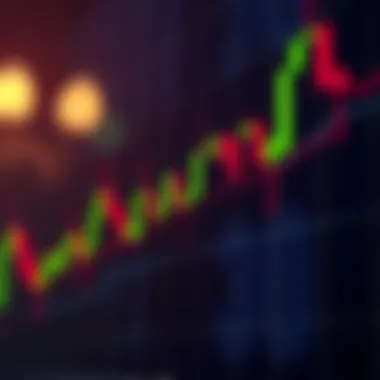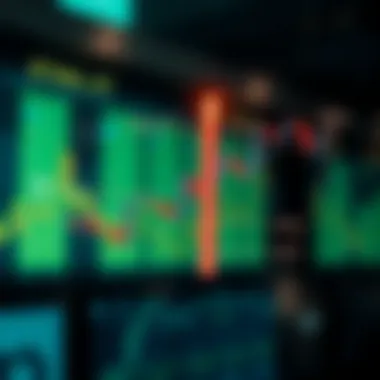Mastering Stock Market Candlesticks for Trading Success


Intro
Candlestick charts are more than just a collection of colored bars on a graph; they are a rich language through which traders communicate their assessments of price movements in the stock market. Understanding these candlesticks is essential for both budding investors and seasoned professionals navigating the often turbulent waters of trading.
Each candlestick represents a specific time period, capturing the opening, closing, high, and low prices of a stock during that interval. Interpreting these patterns can feel like deciphering a complex code. However, mastering this code equips traders with the ability to make informed decisions, enhancing their strategic approaches amid market fluctuations.
The importance of candlestick analysis rests not just on recognizing patterns, but also on comprehending the psychology behind them. Traders’ decisions reflect their emotions—fear, greed, anxiety. By observing the formations that candlesticks create on a chart, one can gain insights into prevailing market sentiment and potential future movements.
In this guide, we will navigate various aspects of candlestick analysis, laying down the foundation for a robust trading strategy. The sections ahead will delve into candlestick formations, significant patterns to watch for, and practical strategies to implement in your trading routine. With the right knowledge and perspective, candlestick charts can become a powerful ally in your investment journey.
Prelims to Candlestick Charts
Understanding candlestick charts is akin to learning a new language in the world of trading. These charts provide a window into market sentiment, blending visual clarity with depth of information. With the rise of trading technologies and methodologies, the use of candlestick charts has become prevalent among both novices and seasoned investors.
Candlestick charts originated in Japan during the 17th century, primarily used for rice trading. What makes them unique and essential is their ability to convey price dynamics in a succinct manner. Unlike traditional line charts, which may obscure pertinent details through aggregation, candlesticks offer a nuanced look into price movement through their distinctive shapes and formations. They tell a story of the market, revealing the battles between buyers and sellers over a specific period.
Benefits of Candlestick Charts:
- Visual Clarity: The shape, color, and size of each candlestick reveal key price movements.
- Engaging Patterns: Traders can identify specific formations that signal potential future movements.
- Quick Analysis: Practicing candlestick recognition allows for expedited decision-making.
In this guide, we will explore the historical background of candlestick charts, followed by an analysis of why they matter in today’s trading landscape. Understanding these elements is vital—without this groundwork, a trader might find themselves adrift in a vast ocean of data and trends, unable to grasp the complete market picture.
Historical Background
The historical journey of candlestick charts traces back to the 1600s when a rice trader, Munehisa Homma, first documented price movements scientifically. His innovative methods allowed traders to visualize trading data, which was revolutionary at the time. Homma’s focus was on understanding how psychological factors influenced price—which helped establish the foundations of what we recognize as modern candlestick analysis.
For centuries, the Japanese refined these techniques, culminating in the widespread use of candlestick charts in the Western market in the late 20th century. The translation of these concepts by Steve Nison brought them into the limelight, rendering them accessible to Western investors. The candlestick chart became a staple in technical analysis textbooks, bridging cultural divides in trading methodologies.
Why Candlesticks Matter
Candlesticks matter for a multitude of reasons, especially when decoding market behaviors. They serve as visual indicators of market direction, allowing traders to quickly assess momentum and reversals. The distinct shapes of various candlesticks—like hammers, dojis, and engulfing patterns—convey information about sentiment, fear, or greed in a trading session.
Moreover, candlestick patterns integrate seamlessly with other analysis techniques. This synergy can lead to comprehensive insights, enabling investors to decide with more confidence. Without the groundwork that candlesticks provide, adapting one’s strategy in response to market fluctuations would feel like trying to shoot fish in a barrel.
"Candlestick charts are more than a visual tool; they encapsulate the emotional heartbeat of the market, allowing traders to navigate effectively through the chaos of trading."
In the following sections, we will delve deeper into the components of candlesticks, types of patterns traders should recognize, and how such analysis can integrate with other trading indicators to hone strategies for financial success.
Components of a Candlestick
Understanding the components of a candlestick is crucial for decoding the often bewildering language of price movement in the stock market. Each candlestick, when viewed collectively, weaves a story of market sentiment, making its components significant in trading analysis. The core elements include the body, wicks (or shadows), open, and close prices. Together, they create visual signals that traders can interpret to make informed decisions, which can be the difference between profit and loss.
Body
The body of a candlestick represents the difference between the opening and closing prices of a particular trading period. Depending on the market movement, the body can either be filled or hollow. A filled body generally indicates that the closing price was lower than the opening price, showcasing downward momentum. Conversely, a hollow body suggests an upward price movement. The size of the body helps traders discern the strength of buying or selling pressure—larger bodies suggest stronger movement, while smaller bodies may indicate indecision in the market.
For example, if a trader sees a long green (hollow) candlestick appearing after a series of smaller red (filled) candlesticks, it might signal a shift in market sentiment, suggesting that buyers are gaining control. In this light, paying attention to the size and color of the body fosters greater insight.
Wicks (Shadows)
Shadows, often called wicks, extend above and below the body and depict the high and low prices during a trading interval. The length of these wicks tells a trader a lot—long upper wicks can indicate rejection of higher prices, illustrating that buyers tried to push prices up but were met with resistance. Conversely, long lower wicks can suggest support levels, where sellers attempted to drive prices down but were unsuccessful.
For instance, a candlestick with a short body and long upper wick may produce a warning signal for potential reversal, suggesting that buyer enthusiasm is waning. Recognizing these subtle signals can provide clarity amidst the market noise, leading to strategic decision-making.
Open and Close Prices
The open and close prices are fundamental to the candlestick's narrative. The open price marks where the security begins a trading period, while the close price reflects where it ends. If the close price is above the open price, it denotes buying strength; if it’s below, it can signal selling pressure.
Understanding the relationship between open and close prices is crucial for spotting trends. Traders often analyze previous candlestick formations to extrapolate future price movements. To truly understand market behavior, one must consider how these prices relate to one another, around crucial support and resistance levels, which can dramatically influence trading strategies during volatile market conditions.
In summary, comprehending these components enhances a trader's toolbox considerably. By mastering the interplay of body, wicks, and the open and close prices, investors can navigate the stock market landscape with a sharper perspective, eliminating guesswork and reducing risk.
Types of Candlestick Patterns
Understanding candlestick patterns is crucial for any trader aiming to decode market sentiment effectively. These patterns, whether single or multiple, allow investors to interpret price actions and make informed decisions. They serve as visual representations of market psychology, sometimes capturing the essence of indecision or confidence among traders. Observing these patterns fosters a deeper comprehension of price trends and trading behavior.
Single Candlestick Patterns


When it comes to trading, single candlestick patterns are like a lone wolf in the forest—often saying a lot in just a brief encounter. These patterns typically highlight a moment of decision in the market, signaling bullish or bearish tendencies. Some common examples include the Doji, Hammer, and Shooting Star.
- Doji: This pattern often indicates indecision in the market. It forms when the open and close prices are nearly the same, resulting in a small body and long wicks. The appearance of a Doji could signal a potential reversal, urging traders to watch for follow-up candles to confirm a trend.
- Hammer: Recognizably shaped like a hammer, this pattern develops when a price falls significantly during the session but rallies before closing near the opening price. It suggests a possible bullish reversal after a downtrend, inviting traders to consider entry points around the breakout level.
- Shooting Star: This pattern appears after an uptrend and indicates a potential bearish reversal. It has a small body with a long upper wick, signaling that the bulls pushed price higher but were overcome by selling pressure by the close.
Recognizing these single candlestick patterns isn't merely academic; it's about developing an intuitive feel for the market, a sense of the underlying dynamics at play. Whether you're a seasoned trader or a novice, these signals can be the compass you need in navigating market waters.
Multiple Candlestick Patterns
Diving deeper, multiple candlestick patterns consist of two or more candles working together to form a more complex expression of market sentiment. These patterns provide stronger signals compared to their single counterparts and often offer a more reliable indication of potential price movements. For instance, consider the Engulfing pattern and the Morning Star.
- Engulfing Patterns: This pattern signals a strong reversal in trend direction. In a bullish engulfing pattern, a small bearish candle is followed by a larger bullish candle that completely engulfs it. Conversely, a bearish engulfing pattern appears during an uptrend, highlighting a shift towards selling pressure. Traders benefit from such patterns by monitoring the preceding trend and assessing the power behind the engulfing signal.
- Morning Star: This three-candle pattern is a classic indicator of a bullish reversal following a downtrend. It begins with a bearish candle, followed by a small-bodied candle, and concludes with a strong bullish candle. The arrangement suggests a shift from selling pressure to buying momentum, potentially driving prices higher.
These multiple candlestick patterns emphasize that understanding the interaction between candles is key to gauging market psychology effectively. Traders who hone their ability to decipher these formations can position themselves more strategically, capitalizing on emerging trends as they unfold.
"Mastering candlestick patterns is not just about recognizing shapes; it's about understanding the story the market is telling you."
By delving into both single and multiple candlestick patterns, traders can enhance their market analysis skills significantly. This knowledge not only enriches their trading toolkit but also sets the stage for more disciplined and informed investing.
For more insights on candlestick patterns, resources can be found at Wikipedia, and further discussions on platforms like Reddit can provide community wisdom.
Key Candlestick Patterns to Recognize
Recognizing key candlestick patterns is like having a secret decoder ring for stock market movements. These patterns serve as signals, hinting at possible price directions. Understanding these formations can be game-changing for traders, allowing them to anticipate bullish or bearish shifts in the market. Notably, price action often reflects emotions and market psychology, giving traders insight into potential trends and reversals.
Doji
A Doji pattern stands out due to its unique formation, where the opening and closing prices are nearly the same. This creates a small body with long wicks on either side. It represents uncertainty in the market, where buyers and sellers are in a fierce tug-of-war. Traders typically interpret a Doji as a potential reversal signal, especially when it appears after a strong trend.
- Indication of Market Balance: The Doji shows that the forces of buyers and sellers are equal, reflecting indecision.
- Strategic Timing: If a Doji forms at the top of an uptrend, it may indicate a potential shift towards bearish sentiment. Conversely, it can suggest bullish reversal when seen at the bottom of a downtrend.
Key takeaway: Spotting a Doji can help traders identify crucial turning points.
Hammer
The Hammer is one of the more recognized candlestick patterns. This pattern resembles a hammer caused by the long lower shadow and a small body near the top of the trading range. It signals a potential bullish reversal, especially after a downtrend.
- Market Rebound: The long shadow indicates that sellers tried to push prices down but buyers stepped in to lift prices higher.
- Significant Confirmation: Traders often look for confirmation in the following candle to solidify the signal before making a move.
Engulfing Patterns
Engulfing patterns consist of two candles—one small followed by a larger opposite candle that completely engulfs the first. There are two types: bullish engulfing (where the second candle is bullish) and bearish engulfing (where it’s bearish). These patterns indicate a potential shift in momentum.
- Bullish Engulfing: This pattern suggests that buyers have taken over from sellers, typically appearing at the end of a downtrend.
- Bearish Engulfing: Conversely, this suggests sellers are resuming control after an uptrend.
Shooting Star
The Shooting Star candlestick has a small body, with a long upper wick and little to no lower wick, forming at the peak of an uptrend. This formation is a red flag, indicating that the bullish trend may be about to reverse.
- Buying Pressure Peaks: The long upper wick signifies that buyers pushed prices up, but sellers took over, driving them back down.
- Sell Signals: After a Shooting Star appears, traders often keep a close eye for confirmation of a trend reversal in subsequent candles.
These key candlestick patterns are not just theoretical; they reflect a trader's understanding of market dynamics. Recognizing these patterns gives traders the ability to make more informed decisions, ultimately refining their trading strategy and improving their outcomes.
Interpreting Candlestick Patterns
Understanding how to interpret candlestick patterns is essential for any trader serious about navigating the stock market. Candlestick charts summarize the price movements for a given period, blending historical price data into a visual representation that can be read easily. However, interpreting these patterns goes beyond mere recognition—it involves understanding the underlying market psychology, the current conditions, and the potential direction of price movements. This section delves into the critical signals and trends that can emerge from candlestick analysis, helping traders make informed decisions based on solid analysis rather than mere speculation.
Bullish vs. Bearish Signals
In candlestick analysis, the differentiation between bullish and bearish signals is foundational. Bullish signals suggest a rise in prices, while bearish signals indicate a potential decline. This dichotomy helps traders decide when to enter or exit positions.
A bullish candlestick, usually characterized by a longer body and a close above its open, indicates that buyers have seized control. Conversely, a bearish candlestick displays a longer body and a close below its open, signaling control by sellers.
Here are key bullish signals to be on the lookout for:
- Hammer: This pattern appears at the bottom of a downtrend and suggests a possible reversal.
- Morning Star: This three-candle pattern indicates a shift in momentum from bearish to bullish.
And for bearish signals:


- Shooting Star: Found at the top of an upward trend, this signifies a potential reversal to the downside.
- Evening Star: Similar to the morning star, but appears at the market's peak, indicating a potential decline.
Understanding these patterns helps traders gauge market sentiment and make informed predictions concerning potential movements.
Trends and Reversals
Trends represent a prevailing direction in stock prices, and recognizing them via candlestick patterns is crucial to successful trading. A trend can be upward, downward, or sideways, and identifying these can simplify decision-making.
For instance, a series of bullish candles can signal an upward trend. Conversely, if prices consistently close lower with bearish candles, this indicates a downward trend. Recognizing these trends allows traders to position themselves advantageously.
However, it’s not just about identifying trends; spotting potential reversal points is equally vital. Reversal patterns disrupt ongoing trends and present new opportunities:
- Doji: This pattern signifies indecision in the market and can be a precursor to trend changes.
- Engulfing Patterns: When a smaller candle is engulfed by a larger candle, it strengthens the potential for a reversal.
These signals don’t work in isolation. It’s imperative to view them in the context of market conditions and combine them with other forms of analysis, such as volume trends or moving averages, to validate interpretations. Traders often find their predictions are more accurate when they can back their observations with technical indicators and broader market insights.
"Interpreting candlestick patterns is not just about charts; it’s about understanding the heartbeat of the market, tapping into the collective mood of investors."
The Importance of Context in Candlestick Analysis
When diving into the world of candlestick analysis, one cannot stress enough the importance of contextualizing the information presented by these vibrant charts. Many traders might fall into the trap of interpreting candlestick patterns in isolation. However, without understanding the surroundings—like the volume traded or the current market conditions—they risk missing the full story. Context serves as the backdrop against which traders evaluate price movements, helping to distinguish between genuine shifts in market sentiment and mere noise.
Candlestick patterns can lead traders down the right path or, conversely, onto a slippery slope of misinterpretation if the broader context is overlooked. This consideration not only enhances the reliability of the patterns but also aligns trading strategies more closely with the prevailing market dynamics, thus increasing the odds of achieving favorable outcomes.
Volume Considerations
Volume is the lifeblood of any market. In candlestick analysis, understanding the volume behind price movements is like reading a book with engaging plot twists—without it, the narrative may be compelling but ultimately lacks depth. A candlestick with high volume signifies strong conviction behind price movements. In contrast, low volume might suggest that there's less interest or certainty about the movement being portrayed.
For example, a bullish engulfing pattern followed by an uptick in volume might indicate that buyers are stepping in with confidence. On the other hand, if the same bullish pattern appears amidst low volume, it could signal a lack of interest that may lead to a quick retracement. Here, one should ask:
- What is the average volume for this stock over the last few days?
- Does this volume align with other indicators?
Incorporating volume into candlestick analysis helps traders filter out false signals, providing a clearer pathway to successful trades.
Market Conditions
Market conditions can be thought of as the weather in the stock market; they set the stage, influencing how different stocks behave. A bullish pattern in a bear market may not carry the same weight as in a bull market. So, it’s crucial for traders to evaluate whether trends are bullish, bearish, or neutral before making decisions based on candlestick formations.
Consider the broader economic factors at play—interest rates, economic indicators, or geopolitical events. Each has the potential to sway market conditions dramatically. For instance, if a trader spots a hammer pattern while the general market is trending downwards, they should exercise caution. The hammer might indicate a potential reversal, but the prevailing bearish trend can undermine its validity.
In summary, to achieve a meaningful interpretation of candlestick patterns, taking into account both volume considerations and market conditions creates a richer analytical framework. This integrated approach not only prevents common pitfalls but also elevates the overall trading strategy.
"Without context, candlestick patterns are just a jumble of data; with context, they tell a compelling story of market sentiment."
In the world of candlestick analysis, context is king. It serves as the vital sign that transforms simple patterns into substantial opportunities.
Integrating Candlestick Analysis with Other Indicators
The world of trading is rife with complexities, and candle stick analysis provides only a partial picture of market movements. Incorporating other indicators enhances decision-making, allowing traders to better understand the market nuances. By combining candle stick patterns with various indicators, traders can form a more comprehensive view of potential price movements. This integrative approach aims to increase the probability of successful trades.
Moving Averages
Moving averages are one of the most commonly used indicators in technical analysis. A moving average smooths out price data, helping to identify trends over a specific period. The two main types are the Simple Moving Average (SMA) and the Exponential Moving Average (EMA).
- Simple Moving Average (SMA): This is just the average price over a selected period. For example, a 20-day SMA takes the average of the last 20 closing prices. It works well for identifying longer-term trends but might lag during fast market movements.
- Exponential Moving Average (EMA): This gives more weight to recent prices, making it more sensitive to new information. Traders often use the 9-day and 21-day EMAs to spot short-term trends.
When you combine candlestick analysis with moving averages, it becomes easier to validate signals. For instance, if a candlestick formation indicates a potential uptrend, and the EMA is also trending upward, it helps to validate the bullish signal. Integrating the two not only aids in confirming entry and exit points but can also enhance stop-loss placement.
Relative Strength Index (RSI)
The Relative Strength Index (RSI) is a momentum oscillator that measures the speed and change of price movements. It ranges from 0 to 100 and is typically used to identify overbought or oversold conditions.
- Interpretation: An RSI above 70 suggests that an asset may be in overbought territory, while an RSI below 30 indicates it may be oversold. This can give traders additional insight when interpreting candlestick patterns.
For instance, if a bullish engulfing pattern appears while the RSI is below 30, this might suggest that a reversal is probable. Conversely, if a bearish shooting star is forming at the same time that the RSI is above 70, it could validate the potential for a downward price movement. Using RSI with candlestick analysis helps to filter false signals and avoid unnecessary trades.
"The integration of various indicators can illuminate the dark corners of the trading landscape, revealing patterns and opportunities that would otherwise be obscured."


Common Mistakes in Candlestick Trading
When diving into the depths of candlestick trading, it's easy to get swept away by the sheer volume of information available. However, knowing the common pitfalls is crucial for any trader looking to make disciplined, well-informed decisions. The mistakes often stem from a lack of understanding or misapplication of the concepts presented in candlestick charts. Recognizing these blunders can save traders from costly errors and build a more sustainable trading strategy.
Ignoring Context
One of the most significant missteps traders make is ignoring the larger market context. Candlestick patterns don't exist in a vacuum; they are often influenced by broader market forces, economic events, and news developments. A bullish engulfing pattern, for example, can signal a potential upward trend, but if it's presented in a weakened overall market or during a significant economic downturn, the signal's reliability diminishes considerably.
Traders should always be aware of the news cycle and trending economic indicators. This means not only checking for earnings reports or rate changes but also understanding geopolitical tensions that may impact market sentiment. For instance, if a trader notices a high volume of buying pressure but overlooks a looming recession, they may find themselves trapped in a position that quickly reverses against them.
In essence, recognizing context is like being a detective; you have to gather all clues to solve the case.
Overreliance on Patterns
Another mistake that frequently occurs is an overreliance on candlestick patterns. While these patterns serve as effective tools in predicting price movements, they are not foolproof. Traders may believe that if they see a doji, for instance, a reversal is imminent, without considering the broader trend or other market indicators.
It's important to utilize candlestick patterns as just one piece of the puzzle. For instance, a hammer might indicate a reversal after a downtrend, but when combined with additional indicators like volume analysis or moving averages, the prediction holds greater weight.
For better decision-making, traders must blend their candlestick analysis with other tools in their arsenal, such as technical indicators or fundamental analysis. This balanced approach leads to a more robust trading strategy and discourages traders from falling into the lure of technical analysis as standalone gospel.
Being cognizant of these common mistakes can help traders not only refine their strategies but also enhance their understanding of the art and science of candlestick trading.
Practical Strategies Using Candlestick Analysis
When it comes to stock market trading, having a reliable strategy can often separate successful traders from those who struggle. Candlestick analysis provides a rich tapestry of information, lending itself to various practical strategies that can help traders make informed decisions. Whether you're a seasoned investor or a novice, grasping how to leverage these patterns effectively can elevate your trading game.
Entry and Exit Points
Identifying the right moments to enter and exit trades is crucial. Candlestick patterns can serve as the compass guiding these decisions. When you see a bullish engulfing pattern following a downtrend, it might indicate a solid entry point. Conversely, a shooting star following an uptrend could signal an impending reversal, suggesting it's time to think about exiting your position or even shorting the stock.
By studying the characteristics of candlesticks, such as their size and position relative to prior candles, you can better gauge market sentiment. Remember, if the candlestick shows strong momentum in the anticipated direction, it's often a green light to make your move. On the other hand, indecision signals, such as a doji, might recommend a more cautious approach. This blend of analytical observation and instinct can help you sharpen your entry and exit strategies significantly.
Setting Stop Losses
Setting stop losses is a safety net that can't be overlooked. Candlestick analysis can help dictate effective levels where these stop losses should be placed. Ideally, set your stop loss just below a recent support level, particularly if you are making a bullish trade. If the market turns against you, this approach can help you limit losses, protecting your investment.
Using candlestick formations adds a layer of insight to your stop loss placement. For instance, if there’s a significant support level that aligns with the tail of a hammer pattern, this could serve as an optimal point to place your stop loss.
"A well-placed stop loss is the unsung hero of trading success; it saves you from the pitfalls of emotional decision-making."
Additionally, it’s wise to remain flexible with your stop losses as new candles develop. If the market starts to trend favourably, consider adjusting your stop loss to a break-even point or re-evaluating it based on new price action. This adaptable approach, guided by candlestick analysis, fortifies your position and can enhance your overall trading performance.
In short, integrating candlestick analysis into your trading toolkit is essential. These strategies help you identify exact entry and exit points while allowing for prudent risk management through effective stop loss settings. By being attentive to the nuances of candlestick formations, traders can ensure a more structured and informed approach to navigating the complex world of stock markets.
Case Studies of Successful Candlestick Trading
Analyzing case studies in candlestick trading can reveal a wealth of knowledge for investors seeking to hone their skills. By delving into real-world examples, traders can grasp how theoretical patterns translate into practical strategies and outcomes. It's one thing to read about candlestick patterns, but witnessing their real-time effectiveness adds a dynamic layer to understanding.
- Why Case Studies Matter: They put theory into action, providing visual confirmation of concepts discussed earlier in the guide. When you see a bullish engulfing pattern successfully triggering a price rally in a stock, it makes the strategy stick. Conversely, seeing a failed pattern highlights the importance of context and caution.
- Deeper Learning: Case studies foster analytical thinking. They require traders to step back and assess results over time, considering what worked and what didn't.
- Patterns in Behavior: Examining historical trading behaviors can give insight into market psychology and sentiment. This understanding can make one more attuned to the fluctuations, allowing for well-informed decisions during trades.
Historical Examples
One noteworthy historical example is the aftermath of the dot-com bubble in the early 2000s. During this period, patterns such as the Doji appeared frequently, signaling indecision among traders. Some astute investors recognized these formations as potential signals of market reversals, leading them to exit positions before major downturns.
Another classic case involves the Hammer candlestick pattern during stock transitions. When the tech stock Amazon started gaining traction in the 1999-2000 boom, traders noticed frequent hammers on its price chart. Those who acted on these patterns often reaped substantial benefits as the stock price surged post-signals.
Modern Applications
In today's digital trading world, social media also plays a significant role in candlestick analysis. Take, for instance, the rise of cryptocurrency. Traders often use platforms like Reddit and trading forums to discuss current charts actively. Some seasoned investors share their experiences regarding specific candlestick patterns that achieved success in volatile markets.
Consider the recent trends surrounding Tesla. Many investors observed reversal patterns like Shooting Stars and used them as signals to enter or exit the stock amidst its notorious price swings. These discussions amplify the practical use of patterns, allowing newer traders to tap into the wisdom of their more experienced counterparts.
Closure
Understanding candlestick patterns is essential for anyone wanting to navigate the stock market effectively. In this article, we’ve explored the intricate details that define candlestick charts - how they form, the meanings behind their shapes, and the various patterns that can signal market trends or reversals. Grasping these concepts isn’t just for show; it’s about equipping yourself with the necessary tools to make informed decisions.
Summarizing Key Points
- Components: We took a closer look at the fundamental components of candlesticks, such as the body and wicks. These parts reveal the story of price movements over a specific timeframe.
- Patterns: The discussion around single and multiple candlestick patterns was crucial. Key patterns like Doji, Hammer, and Engulfing Patterns were highlighted, showing how they can indicate market sentiment shifts.
- Contextual Analysis: Importance of context was a recurring theme. Recognizing that volume and market conditions play a role in interpreting candlestick signals adds another layer of depth to the analysis.
- Common Pitfalls: Understanding the traps that traders can fall into, such as ignoring broader market context and overreliance on singular patterns, was equally essential.
- Practical Strategies: Utilizing candlestick analysis for establishing entry and exit points, as well as setting effective stop losses, provided actionable insights for traders looking to enhance their game.
The Future of Candlestick Analysis
As markets evolve, the relevance of candlestick analysis remains. Traders and investors will likely find that blending traditional candlestick methods with modern analytical tools can amplify insights. Technologies like algorithmic trading could utilize candlestick data, providing real-time analysis that may transform trading strategies. Furthermore, as new trading instruments develop, the adaptability of candlestick patterns will come into play, requiring continuous learning and adjustment of strategies. It’s a dance between time-tested tactics and the need to keep pace with innovation.
"To stay ahead in investing, one must continuously re-evaluate their methods against the tide of change."







